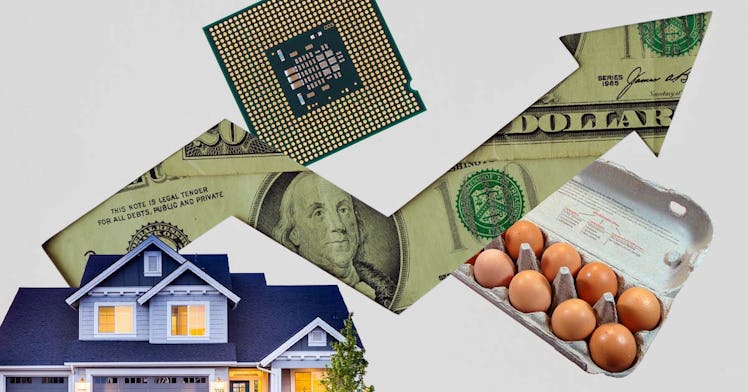Why Everything From Eggs to Houses Are Suddenly So Damn Expensive
Price increases, due to product shortages, will hit every industry.

The past 15 or so months have been a strange one for the American economy. Demand for bicycles and rollerblades skyrocketed, as at-home entertainment trends went in and out of fashion. Groceries increased in price throughout the year, and some foods are far more expensive than they were this time last year. Meat shortages hit grocery stores and fast-food chains.
In the beginning, too, people went gaga for hand sanitizer, bleach, paper towels, and toilet paper, making those products nigh impossible to find in big cities as people stocked up, fearing the worst. In other words, it’s been a somewhat apocalyptic year that strained the supply chain of goods and services that most people depend on or rely on to be available and affordable.
And while the supply chain eventually adapted somewhat to COVID-19 hurdles, a new challenge has reared its head: the reopening of the economy has led to a demand for different products, leading to price increases due to low supply, some similar supply chain problems, and more.
The U.S. economy has been dealing with some so-far anecdotal reports of worker shortages — but more than that, prices of products, like lumber, chicken, and furniture products, have exploded. Here’s what to know.
What Products Are Experiencing Shortages, and Cost Increases, Right Now?
Insider rounded up a massive and deeply helpful list of products experiencing major supply shortages and explained why some of these products are getting really hard to find, seen in largely the order written here. Per the Guardian, it’s incredibly hard to find computer chips, a shortage that affects everything from cars to iPads.
Used cars and rental cars are also experiencing a shortage — if you can remember correctly, rental car companies were selling off their stock at the beginning of the pandemic due to decreased demand, and now that people are trying to go travel again, the car companies need rental cars. And as car supply drops because of the computer chip problem, used cars are also increasing in price and demand.
The price of gasoline has skyrocketed, in no small part due to the massive humanitarian crisis in Texas where the state basically froze over, and also because people are driving again. Plastics, palm oil, and trucking have also been hit — plastics and palm oil largely due to the Texas problem, and trucking because people are buying more and more stuff via delivery, while few trucks, and fewer drivers, make shipping a major problem.
The housing market explosion, one that threatens to squeeze millennials who finally have the money out of the housing market once again, could be a crisis. This is no small part due to the fact that there are fewer homes and a lumber shortage and subsequent price jump as people try to build houses. CNN reports that said lumber shortage can lead to houses costing $36,000 more.
Steel, semiconductors, and copper have all substantially increased in price as well.
Toilet paper, tampons, furniture all mark household items that are still dealing with shortages and price increases. Procter & Gamble, to The New York Times, noted that some baby care, feminine care, and adult incontinence products will likely have increased prices in September.
In late April, Fatherly reported that the cost of staple food commodities was rising at high rates. Poultry, meat, fish, seafood, eggs, fruits, veggies, nonalcoholic beverages, cereal, and baking products had all risen in cost.
Food products like chicken, bacon, and hot dogs are still struggling with COVID-19 related food processing issues; from diseased animals to COVID-19 related processing plant shutdowns, production will take a while to get back to meeting the demand for them.
Apparently, per Insider, coffee, cheese, seafood, and olive oil, aka imported food products, are also facing shipping delays, as ships have to wait weeks to dock in ports in the United States. Corn, which is a food product, but also fuel, has exploded in price for a number of reasons.
Fatherly previously reported on the chlorine shortage, one that threatens to ruin everyone’s good summer swim time.
What Do These Good Shortages Mean for Me and My Family?
The commodity shortages the United States is experiencing, in such disparate areas such as computer chips to chlorine, are caused by supply chain issues, COVID-19 problems, and to some extent, the tariffs that President Trump left in place that were nearly universally described as a terrible economic idea, per The New York Times.
While the Biden admin is clearly keeping an eye on skyrocketing prices and shortages, they aren’t yet too concerned, saying that the shortages are an expected aspect of people’s spending capacity growing (household incomes in the United States increased by nearly a quarter in March, for example) while companies ramp up production, reopen, and deal with the expected growing pains of icing off the economy.
In the meantime, expect to pay a little bit more for the goods that you need, or wait a little bit longer to get those goods… And if you’re buying or building a house, good luck.
This article was originally published on